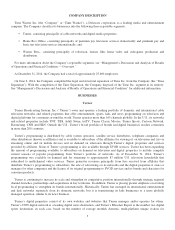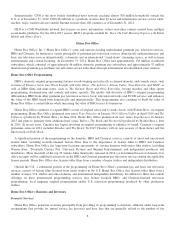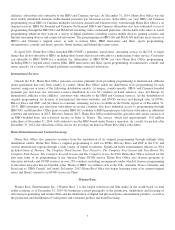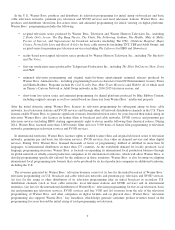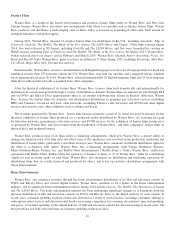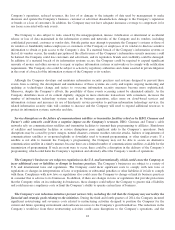Time Magazine 2014 Annual Report Download - page 29
Download and view the complete annual report
Please find page 29 of the 2014 Time Magazine annual report below. You can navigate through the pages in the report by either clicking on the pages listed below, or by using the keyword search tool below to find specific information within the annual report.RISK FACTORS
The Company must respond successfully to changes in technology and consumer behavior to remain competitive. The
Company derives a substantial portion of its revenues and profits from its cable networks, its premium pay television
services and its production and licensing of television programming. Technological changes have driven and reinforced
changes in consumer behavior as consumers seek more control over when, where and how they consume content. These
changes pose long-term risks to the traditional television industry and many of the Company’s historical business models.
These risks include: (i) the disruption of the traditional television content delivery model by over-the-top aggregators of
content if they are successful in drawing large audiences and significant revenues away from, or further discouraging
younger audiences from subscribing to, multichannel video services; (ii) the disruption of the advertising-supported
television model due to increased online video consumption, time-shifted viewing of television programs and the use of
digital video recorders to skip advertisements; (iii) the decline in the value of a network’s acquired programming if it does
not obtain the exclusive right to distribute that programming on both television and digital platforms and that programming
becomes readily available to consumers on other companies’ platforms; (iv) an increase in Turner’s and Home Box Office’s
costs to produce or acquire high-quality, must-watch programming due to heightened competition, including from SVOD
services. The Company’s responses to mitigate the risks from these changes, including the adoption of new business models
and enhancing TV Everywhere, may not be embraced by consumers, advertisers, affiliates or others in the media and
entertainment industry, which could have a significant adverse effect on the Company’s competitive position and its
businesses. In addition, the Company may incur significant costs to respond to, and mitigate the risks from, these changes.
The popularity of content is difficult to predict and can change rapidly, and low public acceptance of the Company’s
content will adversely affect its results of operations. The revenues derived from the sale, distribution and licensing of
television programming, feature films, videogames and other content depend primarily on widespread public acceptance of
that content, which is difficult to predict and can change rapidly. The Company must invest substantial amounts in the
production and marketing of its content before it learns whether such content will reach anticipated levels of popularity with
consumers. The popularity of the Company’s content depends on many factors, only some of which are within the
Company’s control. Examples include the popularity of competing content (including locally produced content
internationally), the availability of alternative forms of leisure and entertainment activities, the Company’s ability to maintain
or develop strong brand awareness and target key audiences, and the Company’s ability to successfully anticipate (and timely
adapt its content to) changes in consumer tastes and behavior in the many countries and territories in which the Company
operates. Low public acceptance of the Company’s content will adversely affect its results of operations.
Generally, feature films that perform well at the box office also have commercial success in subsequent distribution
channels. Therefore, the underperformance of a feature film, especially an “event” film, at the box office can result in lower
than expected revenues for the Company from the license of the film to broadcast and cable networks and SVOD services,
sales of the film via EST and physical discs, and from the sale of videogames or licenses for consumer products based on
such film. There is also a risk that a new “event” film that fails to achieve commercial success at the box office, which would
limit the Company’s ability to create a new theatrical franchise based on the film or characters featured in such film. The
failure to develop successful new theatrical franchises could have an adverse effect on the Company’s results of operations.
With respect to television programming produced by the Company, low ratings for such programming may lead to the
cancellation of a program and can negatively affect future license fees for the cancelled program. A decline in the ratings or
popularity of the television programming aired on Turner’s cable networks can negatively affect advertising revenues for
Turner’s cable networks in the near term and, over a longer period of time, could adversely affect subscription revenues and
the distribution potential of a Turner network. A decline in the popularity of HBO and Cinemax’s programming could, over a
period of time, cause subscribers to cancel their subscriptions, which in turn could adversely affect both the Company’s
subscription and content licensing revenues. In addition, if the Company decides to no longer air programming due to low
ratings or other factors, the Company could incur significant programming impairments, which could have a material adverse
effect on the Company’s results of operations in a given period.
The failure to renew affiliate agreements on favorable terms or at all could cause the Company’s subscription and
advertising revenues to decline. The Company depends on agreements with affiliates for the distribution of Turner’s cable
networks and HBO and Cinemax. Competition from SVOD services and new distribution platforms is increasing the pressure
on affiliates to control their programming costs in order to continue to attract and retain subscribers. As affiliates continue to
13


